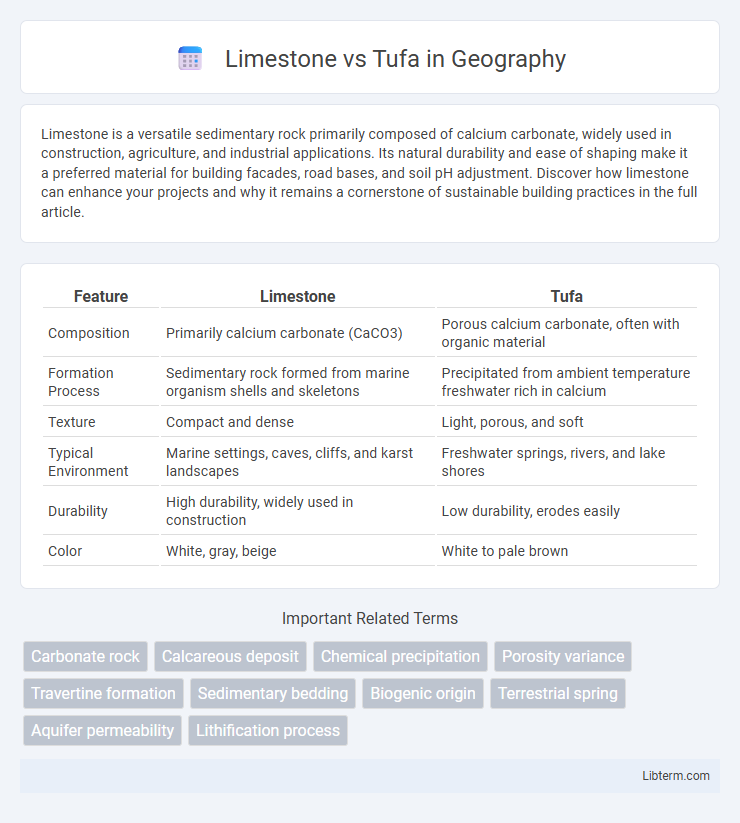Limestone is a versatile sedimentary rock primarily composed of calcium carbonate, widely used in construction, agriculture, and industrial applications. Its natural durability and ease of shaping make it a preferred material for building facades, road bases, and soil pH adjustment. Discover how limestone can enhance your projects and why it remains a cornerstone of sustainable building practices in the full article.
Table of Comparison
| Feature | Limestone | Tufa |
|---|---|---|
| Composition | Primarily calcium carbonate (CaCO3) | Porous calcium carbonate, often with organic material |
| Formation Process | Sedimentary rock formed from marine organism shells and skeletons | Precipitated from ambient temperature freshwater rich in calcium |
| Texture | Compact and dense | Light, porous, and soft |
| Typical Environment | Marine settings, caves, cliffs, and karst landscapes | Freshwater springs, rivers, and lake shores |
| Durability | High durability, widely used in construction | Low durability, erodes easily |
| Color | White, gray, beige | White to pale brown |
Introduction to Limestone and Tufa
Limestone is a sedimentary rock primarily composed of calcium carbonate, formed through the accumulation of marine organism remains such as coral and shell fragments. Tufa is a porous variety of limestone created by the precipitation of calcium carbonate from ambient temperature water bodies, often near springs or waterfalls. Both types of carbonate rocks differ in formation processes and textures but share similar chemical compositions.
Geological Formation: Limestone vs Tufa
Limestone forms primarily through the accumulation and compaction of marine organisms' calcium carbonate shells and skeletons in warm, shallow marine environments, often over millions of years. Tufa, a type of porous limestone, precipitates rapidly from ambient-temperature freshwater rich in calcium carbonate, frequently near springs, rivers, or lakes. The key geological distinction lies in limestone's marine biogenic origin versus tufa's freshwater chemical precipitation.
Physical Properties and Appearance
Limestone is a dense, hard sedimentary rock composed mainly of calcium carbonate, exhibiting a uniform grain size and a smooth, fine texture with colors ranging from white to gray or tan. Tufa is a porous, lightweight limestone formed by the precipitation of calcium carbonate from ambient temperature water, characterized by a spongy texture and typically lighter shades such as white or cream. The physical difference lies in limestone's compactness and durability versus tufa's high porosity and fragility, affecting their suitability for construction and decorative uses.
Chemical Composition Differences
Limestone primarily consists of calcium carbonate (CaCO3), often formed from marine organisms' skeletal fragments, while tufa is a porous variety of limestone created by rapid precipitation of calcium carbonate from ambient temperature water bodies. The key chemical difference lies in their formation environments; limestone typically forms in deeper, stable marine settings promoting compact crystalline structures, whereas tufa forms in freshwater springs or streams with higher levels of dissolved carbon dioxide that encourage rapid deposition and pore development. Variations in trace minerals and impurities such as magnesium carbonate or organic materials further distinguish their chemical compositions and physical properties.
Common Uses in Construction and Design
Limestone is widely used in construction for building blocks, facades, and flooring due to its durability and ease of cutting, while tufa is preferred in landscaping and garden design for its porous texture and lightweight properties. Limestone's dense composition makes it suitable for structural elements and architectural details, whereas tufa's natural aesthetic enhances decorative walls and water features. Both materials offer versatility but serve distinct purposes based on their physical characteristics and load-bearing capabilities.
Durability and Weather Resistance
Limestone is a dense sedimentary rock with high durability and strong resistance to weathering, making it ideal for construction exposed to harsh environments. Tufa, a porous variety of limestone formed by precipitation of carbonate minerals, has significantly lower durability and is more susceptible to erosion and weathering over time. Durability and weather resistance differences are critical when choosing between limestone or tufa for architectural or landscape applications.
Environmental Impact and Sustainability
Limestone extraction often leads to habitat disruption and increased carbon emissions due to energy-intensive quarrying, whereas tufa forms naturally in aquatic environments with minimal ecological disturbance, acting as a carbon sink by trapping atmospheric CO2. Tufa's porous structure promotes biodiversity in freshwater ecosystems, enhancing sustainability compared to the dense, heavily quarried limestone. Sustainable use of tufa supports natural water filtration and carbon sequestration, making it an environmentally preferable choice in construction and landscape applications.
Pros and Cons of Limestone
Limestone offers high durability and versatility, making it ideal for construction, landscaping, and architectural details, while its natural porosity allows for breathability in building materials. However, limestone is susceptible to acid rain and chemical weathering, which can cause surface erosion and structural weakening over time. Maintenance costs can be higher compared to alternatives like tufa, which is softer and easier to carve but less durable.
Pros and Cons of Tufa
Tufa is a porous, lightweight limestone formed by the precipitation of calcium carbonate, often found near mineral springs, offering advantages such as easy workability and natural insulation properties. Its porous nature, however, makes it less durable and more prone to weathering and structural damage compared to denser limestone varieties. Despite its limitations in strength, tufa's unique texture and environmental sustainability make it a popular choice for decorative and landscaping purposes.
Choosing Between Limestone and Tufa: Key Considerations
Choosing between limestone and tufa depends on factors such as porosity, durability, and aesthetic appeal; limestone offers a dense texture with high durability ideal for structural uses, while tufa's porous nature provides superior water absorption, making it suitable for garden and decorative applications. Consider the environmental conditions and intended function, as limestone withstands weathering better, whereas tufa promotes plant growth and retains moisture. Cost and availability also impact decision-making, with limestone generally more expensive but longer-lasting compared to the softer, more affordable tufa.
Limestone Infographic

 libterm.com
libterm.com